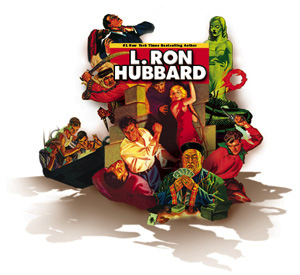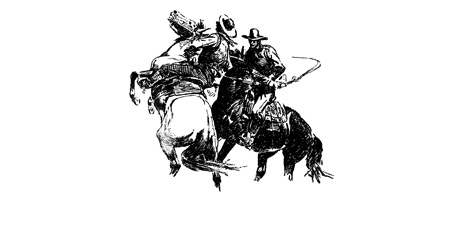Tinhorn's Daughter (8 page)
Read Tinhorn's Daughter Online
Authors: L. Ron Hubbard

JOIN THE PULP REVIVAL
America in the 1930s and 40s
 Â
Â
P
ulp fiction was in its heyday and 30 million readers were regularly riveted by the larger than life tales of master storyteller L. Ron Hubbard. For this was pulp fiction's golden age, when the writing was raw and every page packed a walloping punch.
That magic can now be yours. An evocative world of nefarious villains, exotic intrigues, courageous heroes and heroinesâa world that today's cinema has barely tapped for tales of adventure and swashbucklers.
Enroll today in the Stories from the Golden Age Club and begin receiving your monthly feature edition selected from more than 150 stories in the collection.
You may choose to enjoy them as either a paperback or audiobook for the special membership price of $9.95 each month along with FREE shipping and handling.
Call toll free:
1-877-8GALAXY (1-877-842-5299)
Or go online to
www.goldenagestories.com
And become part of the pulp revival!
Prices are set in US dollars only. For non-US residents, please call 1-323-466-7815 for pricing information. Free shipping available for US residents only.
Galaxy Press, 7051 Hollywood Blvd., Suite 200, Hollywood, CA 90028

Glossary
S
TORIES FROM THE GOLDEN AGE
reflect the words and expressions used in the 1930s and 1940s, adding unique flavor and authenticity to the tales. While a character's speech may often reflect regional origins, it also can convey attitudes common in the day. So that readers can better grasp such cultural and historical terms, uncommon words or expressions of the era, the following glossary has been provided.
aces up:
in high favor or esteem; first rate, fine or outstanding in some way. In some card games, the ace is the highest valued playing card and “aces up” alludes to the fact that the card player has aces in his hand (the cards dealt to or held by each player) and thus a very good chance of winning.
[return to text]
batwing:
one of a pair of batwings; long chaps (leggings worn for protection) with big flaps of leather. They usually fasten with rings and snaps.
[return to text]
Bois-Guilbert, Brian du:
Brian de Bois-Guilbert, a knight and the villain in the novel
Ivanhoe
. He and Ivanhoe are mortal enemies.
[return to text]
box:
the stagecoach driver's seat.
[return to text]
buffalo robe:
the prepared skin of an American bison, with the hair left on, used as a lap robe, rug or blanket.
[return to text]
casque:
an open, conical helmet with a nose guard, commonly used in the medieval period.
[return to text]
chinking:
on a log cabin, the sticks or rocks used to fill the chink (space between the logs).
[return to text]
clapboard:
a type of siding covering the outer walls of buildings in which one edge of each long thin board is thicker than the other. The thick edge of each board overlaps the thin edge of the board below it.
[return to text]
Colt:
a single-action, six-shot cylinder revolver, most commonly available in .45- or .44-caliber versions. It was first manufactured in 1873 for the Army by the Colt Firearms Company, the armory founded by American inventor Samuel Colt (1814â1862) who revolutionized the firearms industry with the invention of the revolver. The Colt, also known as the Peacemaker, was also made available to civilians. As a reliable, inexpensive and popular handgun among cowboys, it became known as the “cowboy's gun” and a symbol of the Old West.
[return to text]
Concord:
manufactured in Concord, New Hampshire, the one-ton “Concord Coach” was the finest road vehicle of its time, costing $1,050. The wheels were made to withstand the heat and cold. The body was strengthened with iron bands and rested on three-inch-thick oxen-leather braces, installed to prevent injury to the horses that were more valuable to the stage line than any passenger. The interior was four feet wide by four and a half feet high, with adjustable leather curtains, and three padded leather seats (known to be harder than the wood beneath them) for nine passengers. The body was so strong that as many as ten or twelve passengers could perch on top. These stages were beautifully colored, red with yellow trim and gold-leaf scrollwork. However, with all of this, long rides were so uncomfortable that they were known to be “cruel and unusual punishment.”
[return to text]
cotillion:
a brisk, lively dance characterized by many intricate steps and the continual changing of partners. Used figuratively.
[return to text]
couch:
a pocket of sorts for placing or holding a spear or the like in a level position and pointed forward, ready for use.
[return to text]
coyote:
a contemptible person, especially a greedy or dishonest one.
[return to text]
dadblamed:
confounded; damned.
[return to text]
double-deck:
a version of the card game blackjack, played with two decks of cards. Used as a nickname.
[return to text]
drop on, got the:
aimed and ready to shoot a gun at an antagonist before the other person's gun can be drawn.
[return to text]
false-front:
describes a façade falsifying the size, finish or importance of a building.
[return to text]
flower, in:
the finest or most flourishing period.
[return to text]
forked leather:
mounted a saddled horse.
[return to text]
forty-four
or
.44:
a .44-caliber rifle.
[return to text]
G-men:
government men; agents of the Federal Bureau of Investigation.
[return to text]
gone to glory:
gone off; lost.
[return to text]
hard-boiled:
tough; unsentimental.
[return to text]
hearse plume:
on antique horse-drawn hearses, a feather plume, usually ostrich feathers dyed black, used to decorate the tops of the horses' heads.
[return to text]
Ivanhoe:
a novel (1819) by Sir Walter Scott (1771â1832), a Scottish novelist and poet who was one of the most prominent figures in English Romanticism.
[return to text]
jack:
money.
[return to text]
jigsawing:
puzzling; exercising one's mind over some problem or matter.
[return to text]
John B.:
Stetson; as the most popular broad-brimmed hat in the West, it became the generic name for
hat
. John B. Stetson was a master hat maker and founder of the company that has been making Stetsons since 1865. Not only can the Stetson stand up to a terrific amount of beating, the cowboy's hat has more different uses than any other garment he wears. It keeps the sun out of the eyes and off the neck; it serves as an umbrella; it makes a great fan, which sometimes is needed when building a fire or shunting cattle about; the brim serves as a cup to water oneself, or as a bucket to water the horse or put out the fire.
[return to text]
lariat:
a long noosed rope used for catching horses, cattle, etc.; lasso.
[return to text]
livery stable:
a stable that accommodates and looks after horses for their owners.
[return to text]
lobo:
wolf; one who is regarded as predatory, greedy and fierce.
[return to text]
locoweed:
any of a number of plants widespread in the mountains of the Western US that make livestock act crazy when they eat them.
[return to text]
longhorn:
a name given the early cattle of Texas because of the enormous spread of their horns that served for attack and defense. They were not only mean, but the slightest provocation, especially with a bull, would turn them into an aggressive and dangerous enemy. They had lanky bodies and long legs built for speed. A century or so of running wild had made the longhorns tough and hardy enough to withstand blizzards, droughts, dust storms and attacks by other animals and Indians. It took a good horse with a good rider to outrun a longhorn.
[return to text]
neck-reined:
guided a horse by pressure of the reins against its neck.
[return to text]
nigh:
the left side (of an animal).
[return to text]
plug:
a flat cake of pressed or twisted tobacco; chewing tobacco.
[return to text]
polecat:
skunk; a thoroughly contemptible person.
[return to text]
puncher:
a hired hand who tends cattle and performs other duties on horseback.
[return to text]
quarter:
mercy or indulgence, especially as shown in sparing a life and accepting the surrender of a vanquished enemy.
[return to text]
quirted:
lashed with a quirt, a flexible, woven-leather whip with a short stock about a foot long.
[return to text]
right-of-way:
the right to build and operate a railway line on land belonging to another, or the land so used.
[return to text]
rimfire saddle:
a saddle with one cinch that is placed far to the front; also called a
Spanish rig
or
rimmy
.
[return to text]
road agent:
stagecoach robber in the mid- to late-nineteenth-century American West.
[return to text]
Scheherazade:
the female narrator of
The Arabian Nights,
who during one thousand and one adventurous nights saved her life by entertaining her husband, the king, with stories.
[return to text]
Sharps:
any of several models of firearms devised by Christian Sharps and produced by the Sharps Rifle Company until 1881. The most popular Sharps were “Old Reliable,” the cavalry carbine, and the heavy-caliber, single-shot buffalo-hunting rifle. Because of its low muzzle velocity, this gun was said to “fire today, kill tomorrow.”
[return to text]
slick as a whistle:
quickly; easily.
[return to text]
sorrel:
a horse with a reddish-brown coat.
[return to text]
tidy:
a small covering, usually ornamental, placed on the backs and arms of upholstered furniture to prevent wear or soiling.
[return to text]
tilt course:
the tournament grounds on which knights rush at or charge one another, as in a joust.
[return to text]
tinhorn:
someone, especially a gambler, who pretends to be important, but actually has little money, influence or skill.
[return to text]
truck farms:
farms growing produce for sale commercially; farms producing truck (vegetables raised for the market).
[return to text]
two bits:
a quarter; during the colonial days, people used coins from all over the world. When the US adopted an official currency, the Spanish milled (machine-struck) dollar was chosen and it later became the model for American silver dollars. Milled dollars were easily cut apart into equal “bits” of eight pieces. Two bits would equal a quarter of a dollar.
[return to text]
vigilantes:
citizens banded together in the West as vigilance committees, without legal sanction and usually in the absence of effective law enforcement, to take action against men viewed as threats to life and property. The usual pattern of vigilance committees was to grab their enemies (guilty or not), stage a sort of trial and hang them. Their other enemies were then likely to get out of town.
[return to text]
Winchester:
an early family of repeating rifles; a single-barreled rifle containing multiple rounds of ammunition. Manufactured by the Winchester Repeating Arms Company, it was widely used in the US during the latter half of the nineteenth century. The 1873 model is often called “the gun that won the West” for its immense popularity at that time, as well as its use in fictional Westerns.
[return to text]
yaller pup:
yellow dog; a cowardly, despicable person.
[return to text]
ye:
the.
[return to text]
